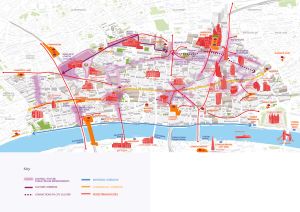Visualising Destination City
In order to understand the ecosystem that makes up the City in pursuit of the Destination City vision, CPA and DSDHA set out to map the City’s existing and future public realm improvements alongside new and approved private developments. This acts as the backbone upon which layers of activity and movement, commerce and culture, meeting places and spaces for nature, could be revealed as new opportunities. We looked to do this through the eyes of visitors, as well as local workers and residents, and their needs and desires, and what is revealed is the foundation of an incredible evolving Destination City.
The City’s public realm projects, supported by developer contributions, offer calm in previously turbulent streets as well as achieving a safer and more effective balance of priorities between pedestrians, cyclists, and vehicle users. Imaginative schemes like the new public realm at Farringdon, improvements at Bank Junction and proposals to transform St Paul’s Gyratory have been at the forefront of the City's urban renaissance, as have the vibrant new cut-throughs and artworks. Meanwhile, improved public realm at Cheapside brings new users and behaviours, restoring a bustling Medieval shop-lined street after the dominance of modern motor traffic.
In terms of future opportunities, we have looked in particular at where people arrive and then move through the City – the pedestrian and cycle flows. These are strong from stations and bridges along main roads, but also increasingly through myriad backstreets to avoid crowds, which is increasingly popular now via mobile technology. By doing so, we are beginning to see the emerging of destinations for the after-hours worker and the tourist, for example, where the latter might choose to walk the short distance between St. Paul's Cathedral and the riverside Tower of London, scouting great places to stop as they pass through the City, coinciding with the latter’s search for pubs with larger areas of outdoor space for drinkers to gather.

A collaborative report from City Property Association(CPA) to identify how the City’s real estate industry, business community and the City Corporation can delivery on it’s Destination City vision.
This report features a series of contributors, including Deborah Saunt, CPA Board and Director. Who identifies a human-focused lens at potential public realm and transport initiatives that could help shape the future of the City. By mapping its urban ecosystem, opportunities, networks and environmental challenges. The research builds on existing pedestrian and transport patterns and identifies the need for a variety of shared public spaces amid the increasing number of the City’s new, approved public and private developments.
The CPA are a not-for-profit membership body and advocacy group representing the major owners, occupiers, developers, investors and advisers to real estate in the City of London. They represent the property industry as a collective voice to inform policy and help drive economic prosperity of the City. Whilst commissioning research and holding informative seminars.